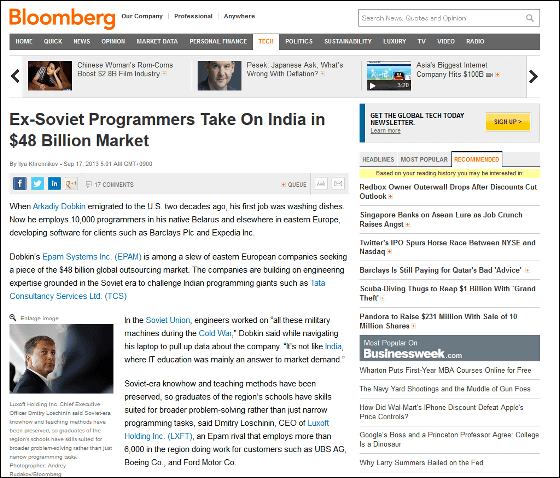A new force from the former Soviet Union that challenges the battle against IT giants and Indian companies

ByKecko
Although it is an IT-related company in India that has played a part of the world's IT industry growth in various fields including system development, programming, support center, companies based in the former Soviet Union extended their forces to destroy their stronghold I am coming.
Ex-Soviet Programmers Take On India in $ 48 Billion Market - Bloomberg
http://www.bloomberg.com/news/2013-09-16/ex-soviet-programmers-take-on-india-in-48-billion-market.html

Arkadiy Dobkin from Belarus, 20 years ago, moved to the United States, the first work he had was "dish-washing". Now that Mr. Dobkin has 10,000 programmers in the Eastern European countries including Belarus and his hometown, "Barclays"Or"Expedia"We are leading companies developing software for companies like.

I am led by DobkinEPAM SystemsIs pursuing business activities targeting the global outsourcing market, which is also said to be a 4.8 billion dollar (about 480 billion yen) market. Based on the technology cultivated in the Soviet Union era, the giant programming worldTataWe are challenging the company against companies in India and other companies. Mr. Dobkin explains the difference between the two companies, "Unlike IT in India, which was mainly responsive to requests from the market, Soviet engineers in the Cold War era have dealt with work related to arms."

Also, with more than 6000 programmers, customersUBSYaBoeing,FordEpam's rival company with a company likeLuxoftAccording to Dmitry Loschinin, CEO of the company, "With the expertise accumulated in the Soviet era and the educational method, we have a broad range of problem-solving skills than programming ability specialized in a narrow range (possessed by Indian companies)."

◆ Programmer's skills
Loschinin says, "Traditionally, Indian programmers are engaged in work in the back, sideload, support, but we can provide a complex solution." In fact, the company's solution has become a bank-oriented derivative trading system, car navigation system that synthesizes to the image of a car camera,Deutsche BankWe are also developing support software to promptly make loan decisions.
Here is one data. This year's programming contest "Google Code Jam, 16 of the 24 finalists were entries from Central and Eastern European countries.
Country Representation - Code Jam 2013 Statistics
http://www.go-hero.net/jam/13/regions

Also, IBM sponsors "ACM International University Counseling Programming Contest"Of the 13 winners, 8 were from the area.
Results 2013
http://icpc.baylor.edu/worldfinals/results

Although it is true that middle - east European programmers are getting higher salaries than Indian, it is said that it is reasonable, because of the sophisticated work than Indian companies. A major Russian financial groupOtkritie CapitalAccording to the company, the average incomes of programmers in Belarus are annual $ 17,000 (about 1.7 million yen), and even in the Russian quasi-metropolitan area 20,000 dollars (about 2 million yen). On the other hand, it is 10,000 dollars (about 1 million yen) in India and $ 95,000 (about 9.5 million yen) in the United States.
◆ "Qualitative" Advantage
Otkritie's analyst Alexander Vengranovich said about the advantages of middle-eastern European programmers "It is creative, has excellent ability to solve problems, qualitatively higher than Indian and Chinese competitors," I am analyzing it. The market of the outsourcing industry as a whole in the last fiscal year was 4.8 billion dollars (about 480 billion yen), a 17% increase compared to the previous year, but the growth rate of the Middle Eastern European companies exceeded it, Epam Sales rose 30% to $ 434 million (about 43 billion yen), while Luxoft also increased sales by 16% to $ 315 million (about 31.5 billion yen). Indian companies against it do not intend to pass market share easily, Tata's growth rate is 29%, its rivalInfosysThe company also shows a 20% growth, both of which refrain from comments.
◆ Growing in America
Based in Pennsylvania, USA, Epam, which is doing real programming in Eastern Europe, has doubled the transaction since last year's initial public offering. Also, Luxoft, headquartered in Switzerland, has been growing by 50% since its initial public offering in June. Mr. Dobkin emigrated to the United States in 1991 when a multinational company started outsourcing its IT operations to India. Mr. Dobkin with a degree in electrical engineering in Belarus has undergone several tasks while learning English, and in 1993 he fulfilled independence. Currently 53 years old Mr. Dobkin says. "I was the only one who did such a thing in New Jersey and my hometown Minsk, there was no funds and there was no connection so we sought to differentiate ourselves from other companies by selling the complexity of work. I decided to go. "

ByHarrypope
It was a turning point in 1995, famous for toothpaste paste etc.ColgateIt was a contract concerning customer relationship management system with the company. If the system is a software companySAPIt caught the eye of Hasso Plattner who was the founder of the company, which led to the contract development of the company.
◆ Dealing with large companies
Epam focused on developing systems like the e-commerce platform, whereas Indian companies grew their performance in the so-called "Year 2000 Problem." as a result,Four SeasonsHotel chain and French cosmetic giantSephora,Coca-Cola, AndAdidasIt led to a deal with a major company called.

BySakeeb Sabakka
"Companies in the former Soviet bloc belong to the same time zone as European countries and are getting a lot of merits because they are close to the US," said Valentin Kazan, vice president of the IBA Group, based in Prague I will talk. "For the enterprise this is a convenient location and because of the geographical and human merits and the ability to provide services within the region, we can reduce costs and speed up our work by building close relationships with our customers. I can speed it up. "

ByGarfield Anderssen
It is Indian IT forces that have continued to grow due to personal skills and cost advantages, but it seems necessary to look at new trends from Central and Eastern Europe as well.
Related Posts:
in Note, Posted by darkhorse_log







